Verdict
A reliable pair of noise-cancelling earbuds – the Onesonic MXS-HD1 are up against some tough competition, but worth a look if solid sound quality, noise cancellation and battery life at an affordable price are on your list of priorities.
Pros
- Solid noise cancellation and audio
- Easy to operate
- Better than expected battery life
Cons
- Fit can cause some discomfort
- Anonymous appearance
- Up against lots of esteemed competition
Availability
- UKRRP: £119.99
- USATBC
- EuropeRRP: €129.99
- CanadaTBC
- AustraliaTBC
-
IP ratingIPX4 rating protected against sweat and splashes of water -
ANCFeature noise cancelling and transparency mode
Introduction
Onesonic is a little-known audio company that’s emerged on our radar due to its reasonably priced products.
There’s a split appeal about cheaper products. The obvious pro is their affordability; but the flip side is that cheap can often be another word for compromise.
That wasn’t the case with the BXS-HD1, which offered a good mix of price and performance. Do we have similar positive things to say about the more expensive, noise-cancelling MXS-HD1?
Design
- Snug fit
- Good interaction with touch controls
- Only available in black finish
The MXS-HD1 differ from the BXS-HD1 in that they incorporate ear-tips, so if you don’t like the “plugged in” feeling of something burrowing into the ear, the BXS-HD1 may hold greater appeal.
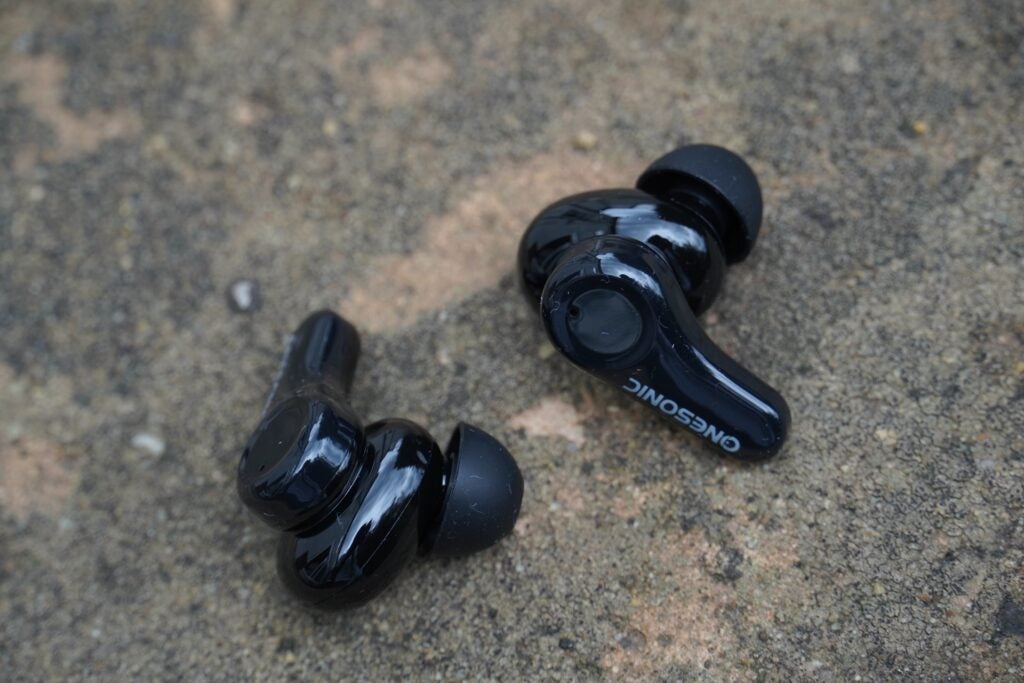
The MXS-HD1’s build quality pushes a hard plastic vibe, although their glossy finish makes them fairly attractive in the flesh. More importantly, they’re not a magnet for fingerprints as the Ugreen HiTune T3. The charging case – perhaps sensibly – doesn’t share the same glossy finish, opting for a matte styling (on the exterior, at least). The oval-shaped case is small, but despite its compact interior, it’s easy to pick out the true wireless buds. The earbuds, much like Batman’s wardrobe, only come in black.
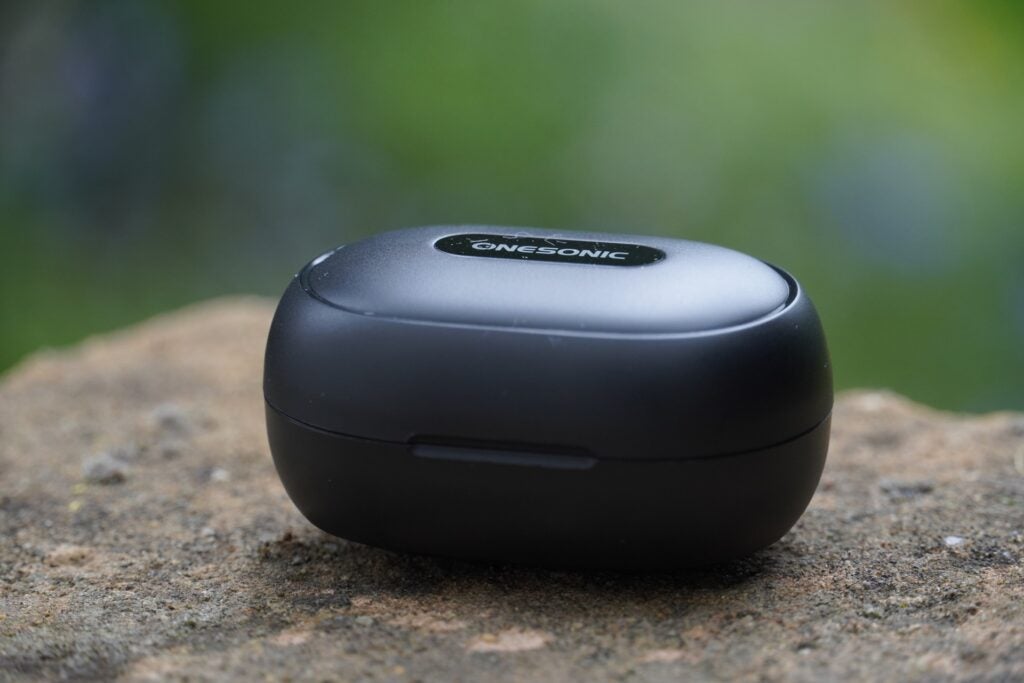
The comfort levels the MXS-HD1 offer are a mixed bag. The fit can be tight, and after a while of wear I found the earphones caused a degree of discomfort. Is it enough to make them unwearable? No, but it can be an unwelcome distraction. It’s a slight shame since the MXS-HD1 slot into the ear super-snugly; but I suspect the use of hard plastic doesn’t help.
The IPX4 rating defends against some water and sweat; light rain, sweaty exercise – that sort of thing. You won’t find many buds with a tougher rating unless they’re built for sports or are made by Jabra.
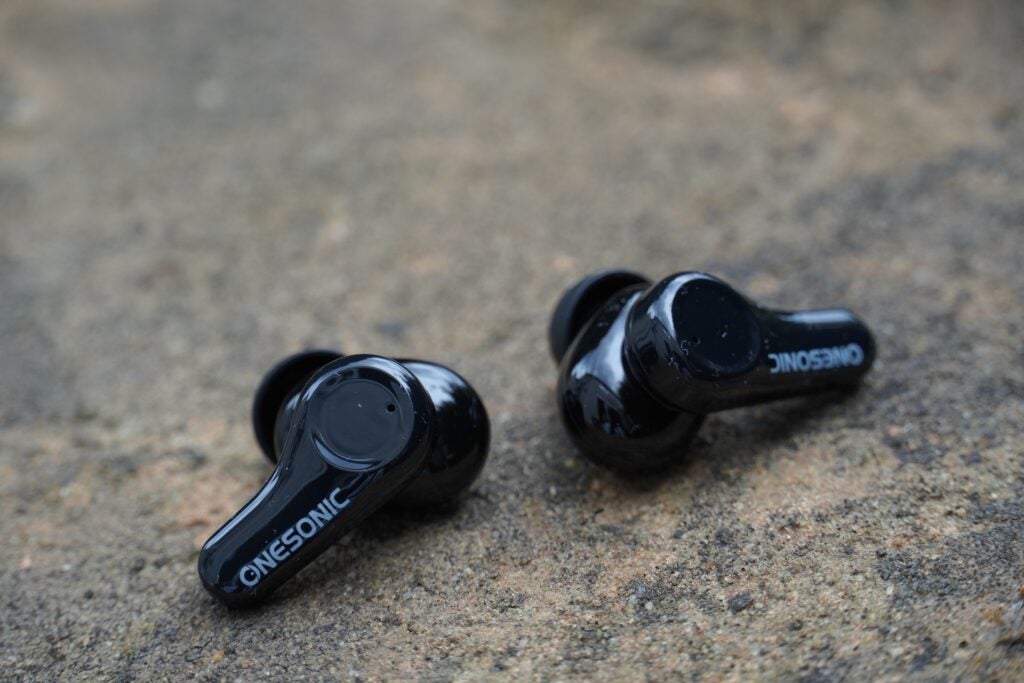
There’s a circular area at the top of the stem where touch controls are located for adjusting volume, playback, noise cancelling, voice assistance and track skipping. That means there’s less need to fish out your smartphone, which is a more convenient and practical solution.
Taps and holds are responsive, with not much pressure needed to operate. The only particular issue I have is the use of a sound effect to signal each noise-cancelling mode. It isn’t a biggie, since it should be obvious which mode the buds are in, but I find it’s much easier to have a voice.
Features
- Battery life seems conservative
- Effective noise cancellation
- Above average call quality
Aside from noise cancellation, the Onesonic’s feature set is best described as modest. However, like I mentioned in the introduction, there’s the other side of the coin – which is that the MXS-HD1’s feature set can be dressed up as keeping things nice and simple.
Wireless connectivity is Bluetooth 5.0 with codec support up to AAC, which covers playback across Android and iOS devices. Walking through busy areas, other than a few blips and minor drop-outs, there was little to get tetchy about.
Battery is quoted at five hours per earphone and 20 hours in general, which is about average around the £100 to £130 price point for ANC earphones. Comparatively, the similarly price Lypertek Z5 ANC offer four hours and the JBL Live Pro 2 deliver 10.
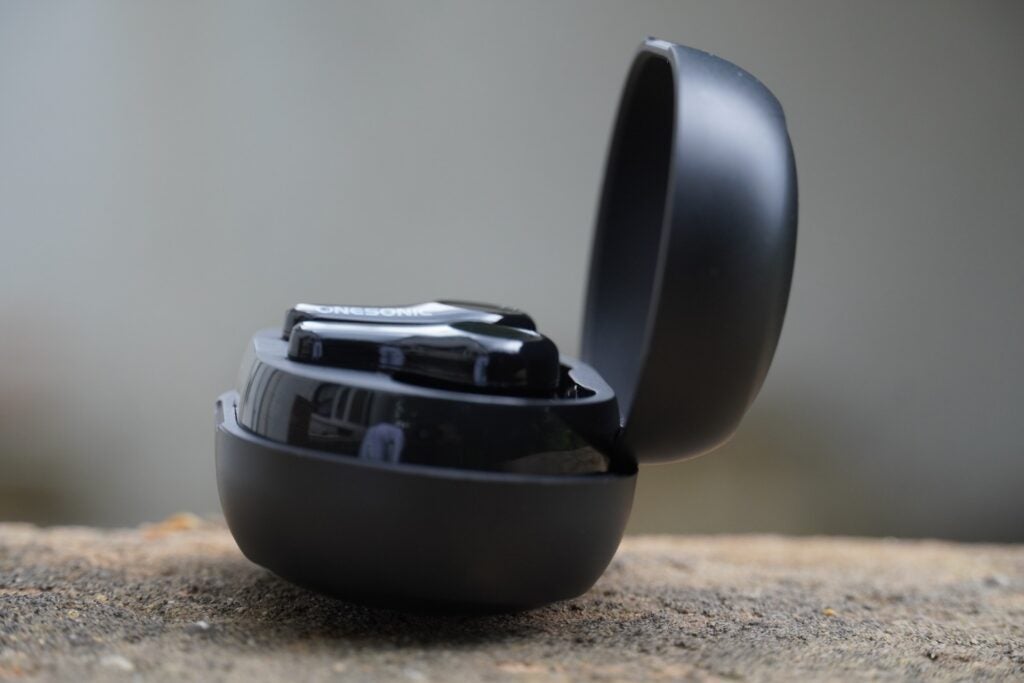
In practice, the Onesonic’s quoted battery is on the conservative side. Two attempts at draining the battery over two-and-a-half hours and the Onesonic hit 70%. That’s around eight hours and a little change in terms of stamina, which is very good. There’s wireless charging support, but no mention of fast-charging.
While the website says the earphones support Siri and Google Assistant, this isn’t native or hands-free support. The native voice assistant can be called up on your mobile whether it’s Google, Alexa or Siri, but to actually use it is to take the device out of your pocket and use your fingers. Not too convenient for the lazy among us.
The Onesonic use a chipset from Chinese firm Bestechnic, which has been used in similarly affordable true wireless buds such as the Urbanista London. Like those earphones, the Onesonic’s noise cancelling is good: people’s voices are less noticeable, ambient noise is turned down appreciably (the background music in a post office faded away), while traffic is effectively subdued to the point where vehicles go past with a less distracting “whoosh”.
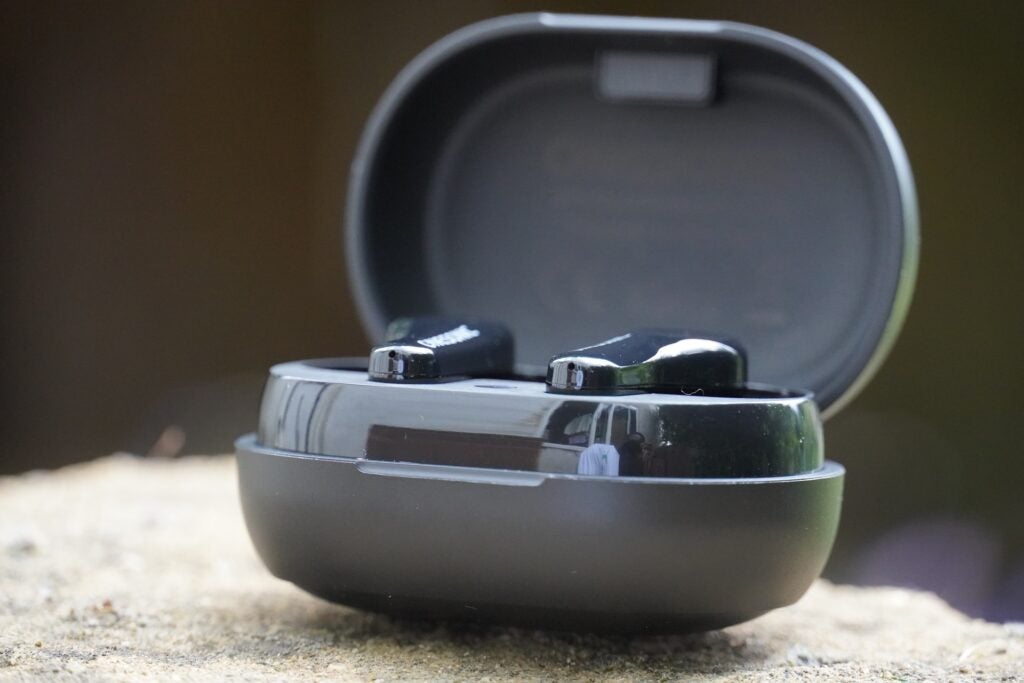
Noise cancelling is effective then, but it does need assistance from the earphones’ volume to block out noises. In addition, like a number of wireless earphones in general, the MXS-HD1’s microphones can be outfoxed by wind noise, amplifying it to the point where on blustery days having noise cancelling on is more of a distraction than a convenience.
The Transparency mode is serviceable, providing decent clarity and detail. In busy areas it can feel as if there is a lots of noise flooding through, lacking the clarity more expensive earphones deliver. However, to catch train announcements or for more awareness in general, the performance is perfectly suitable.
Call quality is above average in that the Onesonic block out most sounds, but voices filter through. The person on the other end of the line mentioned that my voice came through mostly clear, although it sounded as if the buds’ microphones were suppressing background noise too much, since they found it became harder to follow and nearly unintelligible to hear what I was saying when there was more noise around.
Sound Quality
- Quite reserved, but balance at default volume
- More expressive sound at higher volumes
- Punchy bass
Listening to The Offspring’s Come Out and Play, the MXS-HD1 put in an all-round solid performance. Bass is punchily described, with Dexter Holland’s vocals clearly heard above the guitars and drums in the track.
With another punk rock track, The Distillers’ City of Angels, it’s a similar result. Detail of instruments and voices are broadly described, the separation between each instrument and vocals isn’t as sharp or as defined as what you’d get from more expensive earbuds; but the performance is enjoyable, and easy to like.
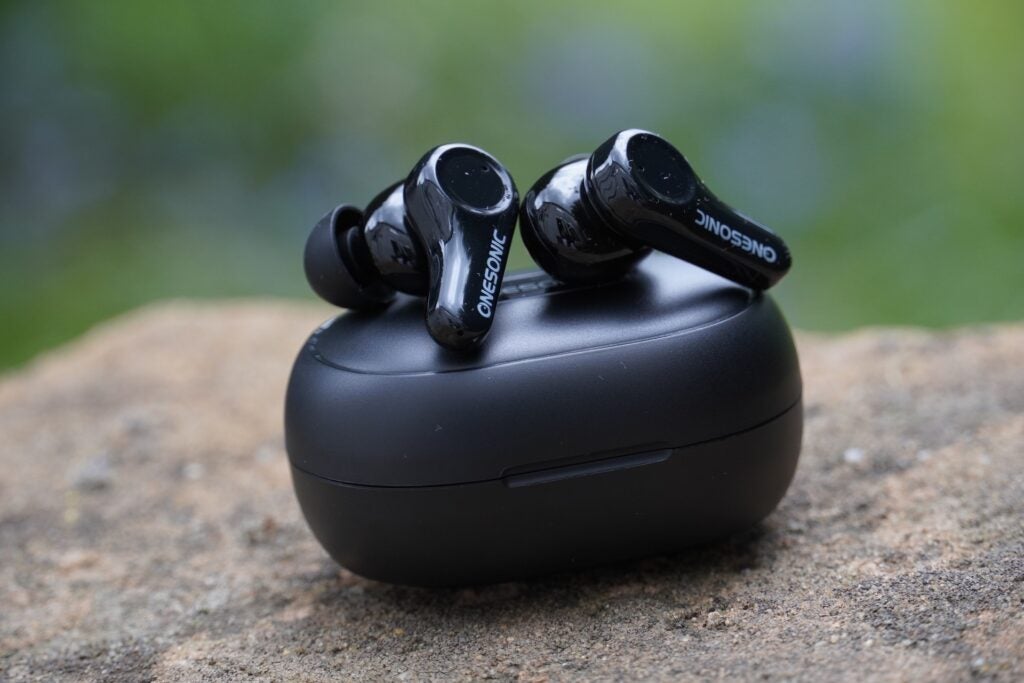
Like seemingly a great deal of true wireless earbuds these days, the Onesonic come across as balanced in their approach but reticent at default volume levels. Flick up the volume and the soundstage expands to be wider, and there’s more energy and drive to the buds’ presentation – especially with more propulsive tracks from genres such as rock and punk rock.
There isn’t much dynamism, though – as in there isn’t a big difference between quiet and loud notes. Again, the Onesonic feel on the reserved side. When songs should soar the Onesonic take a timid approach, the chorus in Cheryl Lynn’s Got to Be Real is played at the same level as the rest of the song; it’s rather one-note in practice.
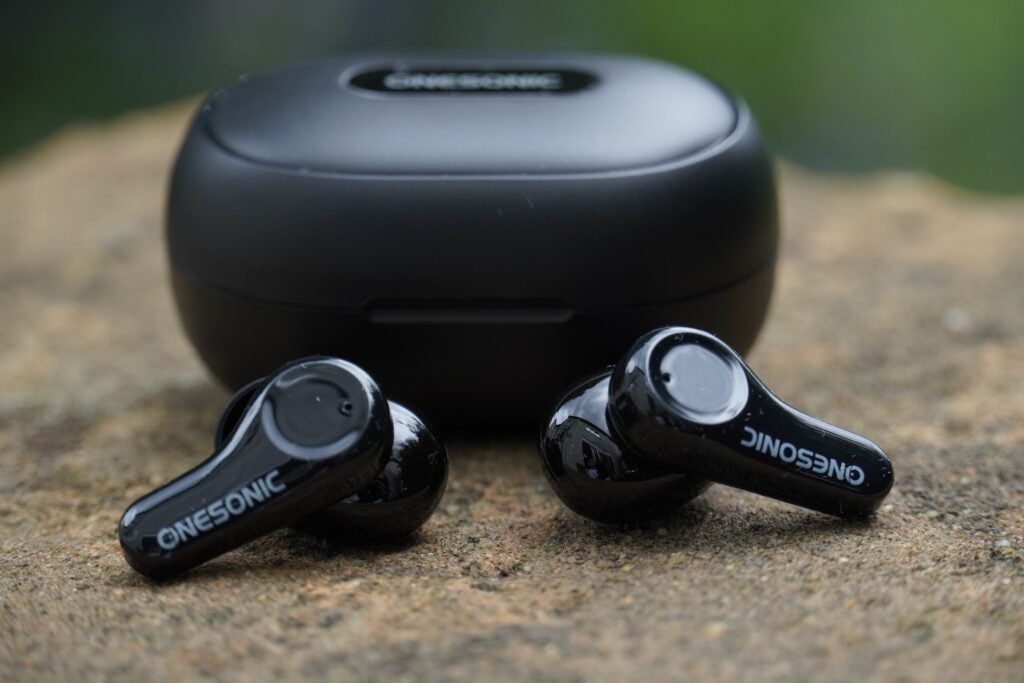
The top-end of the frequency range sounds rolled off and de-fanged. Treble notes are clearly described but lack much brightness at default volumes, with bass present but not strongly presented.
Really, it’s at higher volumes where the Onesonic MXS-HD1 starts to feel confident. Treble notes have some more impact, the dynamic range is more assertively presented, bass is stronger and punchier in GoGo Penguin’s Raven, and the mid-range benefits from having more space to occupy. These buds are of the fun and energetic variety once the volume has been raised, putting in a solid and astute performance.
Latest deals
Should you buy it?
If you’re after a solid, reliable pair As long as you raise the volume, the Onesonic offer good audio and noise cancellation, with battery life that’s better than quoted.
If you don’t like that plugged-in feeling The fit of these buds is snug and did cause a degree of discomfort for me. The cheaper BXS-HD1 don’t boast an ear-tip design as an alternative.
Final Thoughts
The Onesonic MXS-HD1 won’t blow your socks off with their sound, but there’s no doubting that they’re a solid and effective performer. Stamina is better than expected, and although the fit is a little too snug, it aids and abets a solid noise-cancelling performance. The sound quality is solid, too, much more expressive at higher volume levels than it is at default levels – and a higher volume also helps give the ANC an assist in clearing away noise.
There’s a lot of competition around the MXS-HD1’s price point and being a little cheaper might have given them some more breathing space. Nevertheless, the MXS-HD1 are a solid and dependable pair of cheap(er) noise-cancelling earbuds – just be sure to give the volume a boost to hear them at their best.
How we test
We test every headphone we review thoroughly over an extended period of time. We use industry-standard tests to compare features properly. We’ll always tell you what we find. We never, ever, accept money to review a product.
Find out more about how we test in our ethics policy.
Tested with real world use
FAQs
As far as we can tell, the MXS-HD1 support wireless charging but there is no support for fast-charging.
Jargon buster
Bluetooth 5.0
Bluetooth 5.0 is the latest iteration of the standard, and allows data to be sent at twice as much as speed over previous standards, cover four times as much in terms of distance and transfer eight times as much data.
ANC
ANC (Active Noise Cancellation) uses an array of microphones in a headphone to detect the frequency of the sound coming at the listener, with the ANC chip creating an inverse wave (i.e. opposing sound) to suppress any unwanted external noises.
Verdict
A reliable pair of noise-cancelling earbuds – the Onesonic MXS-HD1 are up against some tough competition, but worth a look if solid sound quality, noise cancellation and battery life at an affordable price are on your list of priorities.
Pros
- Solid noise cancellation and audio
- Easy to operate
- Better than expected battery life
Cons
- Fit can cause some discomfort
- Anonymous appearance
- Up against lots of esteemed competition
Availability
- UKRRP: £119.99
- USATBC
- EuropeRRP: €129.99
- CanadaTBC
- AustraliaTBC
-
IP ratingIPX4 rating protected against sweat and splashes of water -
ANCFeature noise cancelling and transparency mode
Introduction
Onesonic is a little-known audio company that’s emerged on our radar due to its reasonably priced products.
There’s a split appeal about cheaper products. The obvious pro is their affordability; but the flip side is that cheap can often be another word for compromise.
That wasn’t the case with the BXS-HD1, which offered a good mix of price and performance. Do we have similar positive things to say about the more expensive, noise-cancelling MXS-HD1?
Design
- Snug fit
- Good interaction with touch controls
- Only available in black finish
The MXS-HD1 differ from the BXS-HD1 in that they incorporate ear-tips, so if you don’t like the “plugged in” feeling of something burrowing into the ear, the BXS-HD1 may hold greater appeal.

The MXS-HD1’s build quality pushes a hard plastic vibe, although their glossy finish makes them fairly attractive in the flesh. More importantly, they’re not a magnet for fingerprints as the Ugreen HiTune T3. The charging case – perhaps sensibly – doesn’t share the same glossy finish, opting for a matte styling (on the exterior, at least). The oval-shaped case is small, but despite its compact interior, it’s easy to pick out the true wireless buds. The earbuds, much like Batman’s wardrobe, only come in black.

The comfort levels the MXS-HD1 offer are a mixed bag. The fit can be tight, and after a while of wear I found the earphones caused a degree of discomfort. Is it enough to make them unwearable? No, but it can be an unwelcome distraction. It’s a slight shame since the MXS-HD1 slot into the ear super-snugly; but I suspect the use of hard plastic doesn’t help.
The IPX4 rating defends against some water and sweat; light rain, sweaty exercise – that sort of thing. You won’t find many buds with a tougher rating unless they’re built for sports or are made by Jabra.

There’s a circular area at the top of the stem where touch controls are located for adjusting volume, playback, noise cancelling, voice assistance and track skipping. That means there’s less need to fish out your smartphone, which is a more convenient and practical solution.
Taps and holds are responsive, with not much pressure needed to operate. The only particular issue I have is the use of a sound effect to signal each noise-cancelling mode. It isn’t a biggie, since it should be obvious which mode the buds are in, but I find it’s much easier to have a voice.
Features
- Battery life seems conservative
- Effective noise cancellation
- Above average call quality
Aside from noise cancellation, the Onesonic’s feature set is best described as modest. However, like I mentioned in the introduction, there’s the other side of the coin – which is that the MXS-HD1’s feature set can be dressed up as keeping things nice and simple.
Wireless connectivity is Bluetooth 5.0 with codec support up to AAC, which covers playback across Android and iOS devices. Walking through busy areas, other than a few blips and minor drop-outs, there was little to get tetchy about.
Battery is quoted at five hours per earphone and 20 hours in general, which is about average around the £100 to £130 price point for ANC earphones. Comparatively, the similarly price Lypertek Z5 ANC offer four hours and the JBL Live Pro 2 deliver 10.

In practice, the Onesonic’s quoted battery is on the conservative side. Two attempts at draining the battery over two-and-a-half hours and the Onesonic hit 70%. That’s around eight hours and a little change in terms of stamina, which is very good. There’s wireless charging support, but no mention of fast-charging.
While the website says the earphones support Siri and Google Assistant, this isn’t native or hands-free support. The native voice assistant can be called up on your mobile whether it’s Google, Alexa or Siri, but to actually use it is to take the device out of your pocket and use your fingers. Not too convenient for the lazy among us.
The Onesonic use a chipset from Chinese firm Bestechnic, which has been used in similarly affordable true wireless buds such as the Urbanista London. Like those earphones, the Onesonic’s noise cancelling is good: people’s voices are less noticeable, ambient noise is turned down appreciably (the background music in a post office faded away), while traffic is effectively subdued to the point where vehicles go past with a less distracting “whoosh”.

Noise cancelling is effective then, but it does need assistance from the earphones’ volume to block out noises. In addition, like a number of wireless earphones in general, the MXS-HD1’s microphones can be outfoxed by wind noise, amplifying it to the point where on blustery days having noise cancelling on is more of a distraction than a convenience.
The Transparency mode is serviceable, providing decent clarity and detail. In busy areas it can feel as if there is a lots of noise flooding through, lacking the clarity more expensive earphones deliver. However, to catch train announcements or for more awareness in general, the performance is perfectly suitable.
Call quality is above average in that the Onesonic block out most sounds, but voices filter through. The person on the other end of the line mentioned that my voice came through mostly clear, although it sounded as if the buds’ microphones were suppressing background noise too much, since they found it became harder to follow and nearly unintelligible to hear what I was saying when there was more noise around.
Sound Quality
- Quite reserved, but balance at default volume
- More expressive sound at higher volumes
- Punchy bass
Listening to The Offspring’s Come Out and Play, the MXS-HD1 put in an all-round solid performance. Bass is punchily described, with Dexter Holland’s vocals clearly heard above the guitars and drums in the track.
With another punk rock track, The Distillers’ City of Angels, it’s a similar result. Detail of instruments and voices are broadly described, the separation between each instrument and vocals isn’t as sharp or as defined as what you’d get from more expensive earbuds; but the performance is enjoyable, and easy to like.

Like seemingly a great deal of true wireless earbuds these days, the Onesonic come across as balanced in their approach but reticent at default volume levels. Flick up the volume and the soundstage expands to be wider, and there’s more energy and drive to the buds’ presentation – especially with more propulsive tracks from genres such as rock and punk rock.
There isn’t much dynamism, though – as in there isn’t a big difference between quiet and loud notes. Again, the Onesonic feel on the reserved side. When songs should soar the Onesonic take a timid approach, the chorus in Cheryl Lynn’s Got to Be Real is played at the same level as the rest of the song; it’s rather one-note in practice.

The top-end of the frequency range sounds rolled off and de-fanged. Treble notes are clearly described but lack much brightness at default volumes, with bass present but not strongly presented.
Really, it’s at higher volumes where the Onesonic MXS-HD1 starts to feel confident. Treble notes have some more impact, the dynamic range is more assertively presented, bass is stronger and punchier in GoGo Penguin’s Raven, and the mid-range benefits from having more space to occupy. These buds are of the fun and energetic variety once the volume has been raised, putting in a solid and astute performance.
Latest deals
Should you buy it?
If you’re after a solid, reliable pair As long as you raise the volume, the Onesonic offer good audio and noise cancellation, with battery life that’s better than quoted.
If you don’t like that plugged-in feeling The fit of these buds is snug and did cause a degree of discomfort for me. The cheaper BXS-HD1 don’t boast an ear-tip design as an alternative.
Final Thoughts
The Onesonic MXS-HD1 won’t blow your socks off with their sound, but there’s no doubting that they’re a solid and effective performer. Stamina is better than expected, and although the fit is a little too snug, it aids and abets a solid noise-cancelling performance. The sound quality is solid, too, much more expressive at higher volume levels than it is at default levels – and a higher volume also helps give the ANC an assist in clearing away noise.
There’s a lot of competition around the MXS-HD1’s price point and being a little cheaper might have given them some more breathing space. Nevertheless, the MXS-HD1 are a solid and dependable pair of cheap(er) noise-cancelling earbuds – just be sure to give the volume a boost to hear them at their best.
How we test
We test every headphone we review thoroughly over an extended period of time. We use industry-standard tests to compare features properly. We’ll always tell you what we find. We never, ever, accept money to review a product.
Find out more about how we test in our ethics policy.
Tested with real world use
FAQs
As far as we can tell, the MXS-HD1 support wireless charging but there is no support for fast-charging.
Jargon buster
Bluetooth 5.0
Bluetooth 5.0 is the latest iteration of the standard, and allows data to be sent at twice as much as speed over previous standards, cover four times as much in terms of distance and transfer eight times as much data.
ANC
ANC (Active Noise Cancellation) uses an array of microphones in a headphone to detect the frequency of the sound coming at the listener, with the ANC chip creating an inverse wave (i.e. opposing sound) to suppress any unwanted external noises.

























